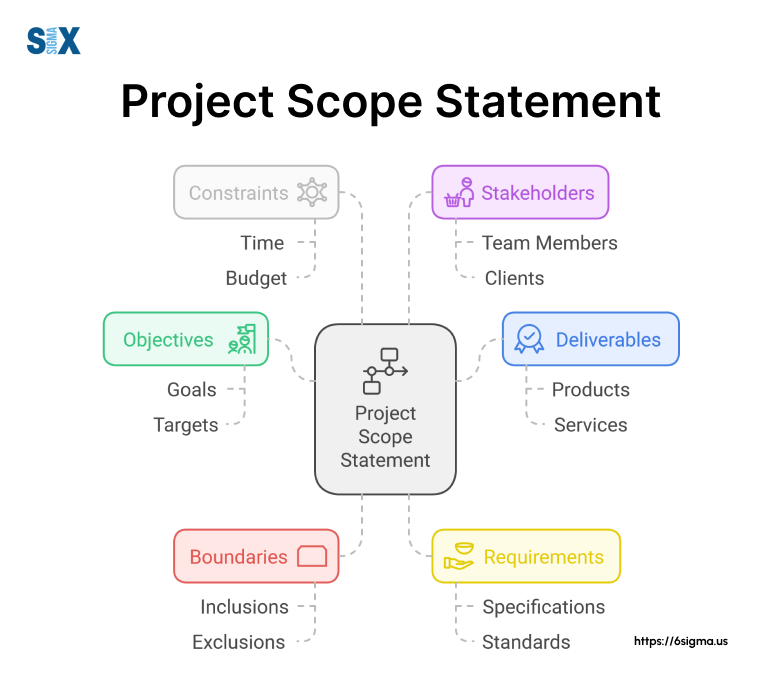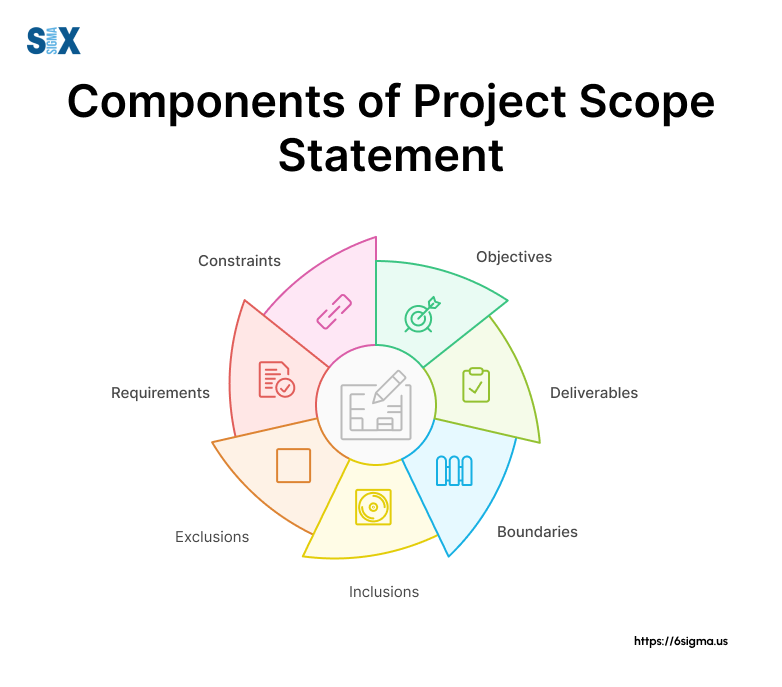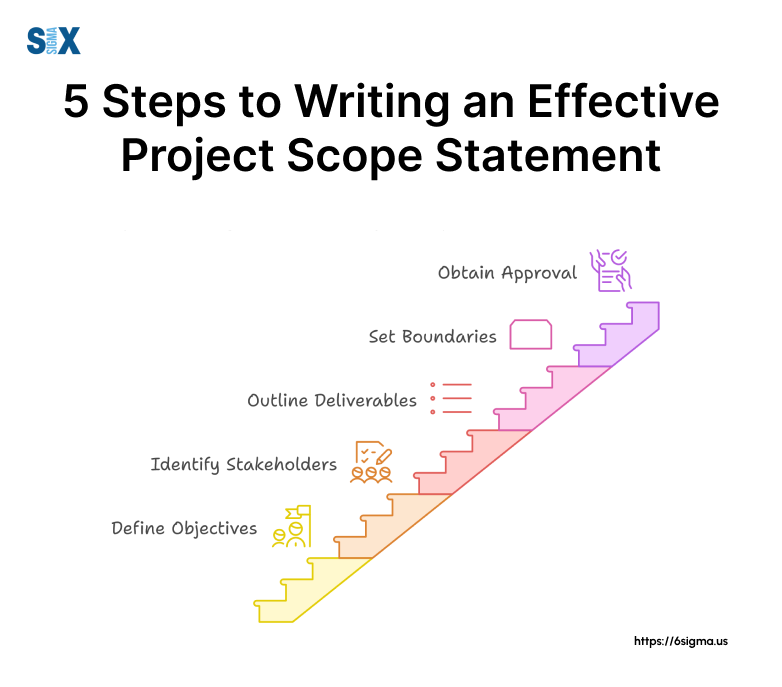Project Scope Statement: The Key to Project Success
A well-crafted project scope statement can be the difference between project success and failure.
A project scope statement is a comprehensive document that defines the boundaries, deliverables, and objectives of a project.
It serves as a roadmap for the entire project team, stakeholders, and clients, ensuring everyone is aligned on what the project will and will not accomplish.
Key Highlights
- Definition and importance
- How to create them effectively
- The ins and outs of project scope statements
- Step-by-step how to write a project scope statement
- Discover common pitfalls
- Tools and techniques for scope management
What is a Project Scope Statement?
As we delve deeper into the world of project management, it’s crucial to understand the cornerstone document that guides every successful project: the project scope statement.
Think of it as the GPS for your project journey, providing clear directions and boundaries to keep everyone on track.
Definition and Purpose
A project scope statement is a comprehensive document that outlines the boundaries, deliverables, and objectives of a project.
Its primary purpose is to provide a clear, concise, and agreed-upon description of what the project will accomplish.
This critical document serves as a reference point throughout the project lifecycle, helping to prevent scope creep and ensuring all stakeholders are aligned on the project’s goals and limitations.

Key Components of a Project Scope Statement
A well-crafted project scope statement typically includes the following elements:
- Project Objectives: Clear, measurable goals the project aims to achieve
- Deliverables: Tangible outcomes or products the project will produce
- Project Boundaries: What is and isn’t included in the project scope
- Constraints: Limitations on time, budget, or resources
- Assumptions: Factors believed to be true for planning purposes
- Acceptance Criteria: Standards that must be met for project completion
How Project Scope Statement Differs from Other Project Documents
While a project scope statement is essential, it’s important to understand how it differs from other project management documents:
| Document | Purpose | Key Difference |
|---|---|---|
| Project Charter | Authorizes the project | High-level overview |
| Project Plan | Outlines how the project will be executed | Detailed schedule and resource allocation |
| Work Breakdown Structure (WBS) | Breaks down project tasks | Hierarchical task list |
| Project Scope Statement | Defines project boundaries and deliverables | Comprehensive scope definition |
The project scope statement stands out as the definitive guide to what the project will and won’t deliver, providing a level of detail that bridges the gap between high-level charters and granular task lists.

The Importance of Project Scope Statements
A well-crafted project scope statement can make or break a project.
Benefits for Project Management
A project scope statement is more than just a document; it’s a powerful tool that helps teams navigate the complexities of execution.
Here’s how a project scope statement helps a project team:
- Clarity and Alignment: It ensures everyone understands the project’s objectives, deliverables, and boundaries.
- Resource Allocation: It helps in accurately estimating and allocating resources based on the defined scope.
- Risk Management: By clearly defining what’s in and out of scope, it helps identify potential risks early on.
- Stakeholder Management: It sets realistic expectations for stakeholders, reducing conflicts and misunderstandings.
Role of Project Scope Statement in Preventing Scope Creep
One of the most significant benefits of a project scope statement is its role in preventing scope creep.
Scope creep, the gradual expansion of a project’s scope without proper control, can derail even the most well-planned projects.
A clear, comprehensive scope statement acts as a reference point, allowing project managers to easily identify and manage change requests that fall outside the agreed-upon scope.
Impact on Project Success Rates
Statistics consistently show that projects with well-defined scope statements have higher success rates.
An expert quote from Sarah Johnson, PMP, underscores this point:
A comprehensive project scope statement is like a project’s North Star. It guides decision-making, keeps the team focused, and significantly increases the likelihood of project success.
Remember, this is not just a bureaucratic requirement; it’s a living document that should be referred to regularly and updated as necessary.
Step-by-Step Guide to Writing a Project Scope Statement
Learning how to write a project scope statement is a crucial skill for any project manager.
This comprehensive guide will walk you through the process, ensuring you create a clear and effective document that sets your project up for success.
Gathering Necessary Information
Before you start writing, collect all relevant project information:
- Project charter
- Stakeholder requirements
- Business case
- Preliminary budget and timeline estimates
This information forms the foundation of your scope statement and ensures alignment with overall business objectives.
Defining Project Objectives and Deliverables with the Project Scope Statement
Clearly articulate what the project aims to achieve and what it will produce:
- Objectives: Use SMART criteria (Specific, Measurable, Achievable, Relevant, Time-bound)
- Deliverables: List tangible outputs the project will produce
Example: For a website redesign project, an objective might be “Increase user engagement by 30% within three months of launch,” while a deliverable could be “A mobile-responsive website with updated content management system”.
Identifying Constraints and Assumptions
Document factors that may limit the project or are presumed to be true:
- Constraints: Budget limitations, deadlines, resource availability
- Assumptions: Factors believed to be true for planning purposes
Be thorough here, as overlooked constraints or incorrect assumptions can derail a project later.
Outlining Project Boundaries with the Project Scope Statement
Clearly define what is in and out of scope:
- In-scope: Tasks and deliverables that are part of the project
- Out-of-scope: Items explicitly not included in the project
This section is crucial for managing stakeholder expectations and preventing scope creep.
Determining Acceptance Criteria
Specify the standards that must be met for the project to be considered complete:
- Quantitative measures: Performance metrics, quality standards
- Qualitative measures: Stakeholder satisfaction, user experience
These criteria provide a clear finish line for the project and help in assessing its success.

By following these steps, you’ll create a comprehensive project scope statement that guides your project to success.
Want to learn in detail how to create it? Get to know detailed explanation of creating project scope statements with Lean Six Sigma Green Belt
Common Mistakes in Creating Project Scope Statements
Even experienced project managers can fall into traps when creating project scope statements.
By understanding these common pitfalls, you can avoid them and create more effective documents.
Lack of Detail
One of the most common errors is not providing enough detail in the project scope statement. Vague descriptions can lead to misunderstandings and scope creep later in the project.
What Not to Do: “Improve company website”
Better Approach: “Redesign the company website to be mobile-responsive, improve load times by 50%, and integrate a new e-commerce platform within 4 months”
Ambiguous Language
Using unclear or ambiguous language can create confusion and leave room for misinterpretation. Always strive for clarity and specificity in your scope statement.
What Not to Do: “Implement new software system soon”
Better Approach: “Install and configure a CRM software for the sales department, complete user training, and go live by September 30th”
Failing to Involve Stakeholders
Creating a project scope statement in isolation can lead to missed requirements and lack of buy-in.
Engage key stakeholders throughout the process to ensure all perspectives are considered.
What Not to Do: Write the scope statement alone and present it as a final document
Better Approach: Conduct stakeholder interviews, hold collaborative workshops, and circulate drafts for feedback before finalizing
Overlooking Potential Risks
Every project faces risks, and failing to acknowledge them can leave your team unprepared. Include a section on potential risks and mitigation strategies.
What Not to Do: Assume everything will go according to plan
Better Approach: “Identified risks include potential supply chain disruptions. We will mitigate this by identifying backup suppliers and maintaining a 2-week inventory buffer.”
Remember, a well-crafted project scope statement is your roadmap to success.
Take part in discussion of pitfalls in scope statement creation with Lean Six Sigma Black Belt to avoid any common mistakes
Tools and Techniques for Scope Management
Effective scope management is crucial for project success, and fortunately, there are several tools and techniques available to help project managers maintain control over their project scope.
Work Breakdown Structure (WBS)
The Work Breakdown Structure is a hierarchical decomposition of the total scope of work to be carried out by the project team.
It’s an essential tool that helps break down complex projects into manageable components.
Key benefits of using a WBS:
- Provides a clear visual representation of the project scope
- Helps identify all required deliverables
- Facilitates accurate time and cost estimation
- Supports resource allocation and task assignment
Requirements Traceability Matrix and the Project Scope Statement
A Requirements Traceability Matrix (RTM) is a document that links project requirements throughout the project lifecycle.
It’s particularly useful for ensuring that the project scope statement aligns with stakeholder needs and project deliverables.
Components of an RTM typically include:
- Requirement ID
- Requirement description
- Source of the requirement
- Priority
- Current status
- Test case ID (if applicable)
Using an RTM helps maintain focus on approved requirements and prevents scope creep by clearly documenting the origin and approval status of each requirement.
Scope Management Software Options
Modern project management software often includes features specifically designed for scope management.
These tools can help automate and streamline the process of creating and maintaining your scope statement.
Popular scope management software features:
- Interactive WBS creation
- Requirement tracking and management
- Change request handling
- Integration with other project management processes
Some top-rated project management tools with strong scope management features include:
- Microsoft Project
- Jira
- Asana
- Trello
- Smartsheet
When selecting a tool, consider factors such as your team size, project complexity, and integration capabilities with your existing systems.
Remember, while these tools and techniques are valuable, they’re most effective when used in conjunction with a well-crafted project scope statement.
Conclusion
Throughout this comprehensive guide, we’ve explored the critical role that project scope statements play in successful project management.
We’ve delved into what a scope statement is, how it helps a team, and provided step-by-step instructions on how to write an effective one.
Remember, a well-crafted project scope statement serves as the foundation for your entire project.
It clearly documents what the project includes, defines boundaries, and sets expectations for all stakeholders.
By following the guidelines and examples we’ve provided, you can create a robust statement that will guide your project to success.
Key takeaways include:
- The importance of clarity and detail in your scope statement
- The need to involve stakeholders in the scope definition process
- The value of regularly reviewing and updating your scope statement
Now it’s your turn to put this knowledge into practice.
Remember, the more you practice, the better you’ll become at defining and managing project scopes effectively.
Take action today and set your next project up for success with a comprehensive project scope statement.
SixSigma.us offers both Live Virtual classes as well as Online Self-Paced training. Most option includes access to the same great Master Black Belt instructors that teach our World Class in-person sessions. Sign-up today!
Virtual Classroom Training Programs Self-Paced Online Training Programs







